An object is positioned at A and wants to move to B. I want to calculate a movement vector there that doesn't move within the distance D of the to-be-avoided points in array C.
So if the move vector (B-A) normalized and multiplied with the objects speed would bring it within D of any point in C the vector is rotated so that it doesn't.
This is in two dimensions. Also, if this operation has a name, please make a comment or edit this question yourself as I had no idea of what to call it.
Also, my first instinct was to divide the active area into nodes and run a A* but I want to try the mathematical approach on this one, a few experiments with flocking gives me the impression that it can be done.
Update (from comments): This image is very close to the solution I want:

Assuming we start at the point to the left, we start turning right towards the goal (the other point), we detect a wall on the right so we stop turning and move forward. The wall is gone so we are allowed to start turning towards the goal again, and so on. I know this may cause the object to not get there at all, but I want to define a behavior, not necessarily a solution, if you know what I mean.
Update2: Translating the active area into a set of nodes might prove inefficient. A* and other heuristic graph traversal algorithms are great for low dimensional problems. But the area I want to move across is infinite in size and only has a handful of obstacles scattered across it. The nodes themselves, or rather the potential positions, are infinitely small. This could of course be optimized with a quad tree of some sort but I have a feeling simple movement vectors that are in some way rotated and interpolated can solve this as well.